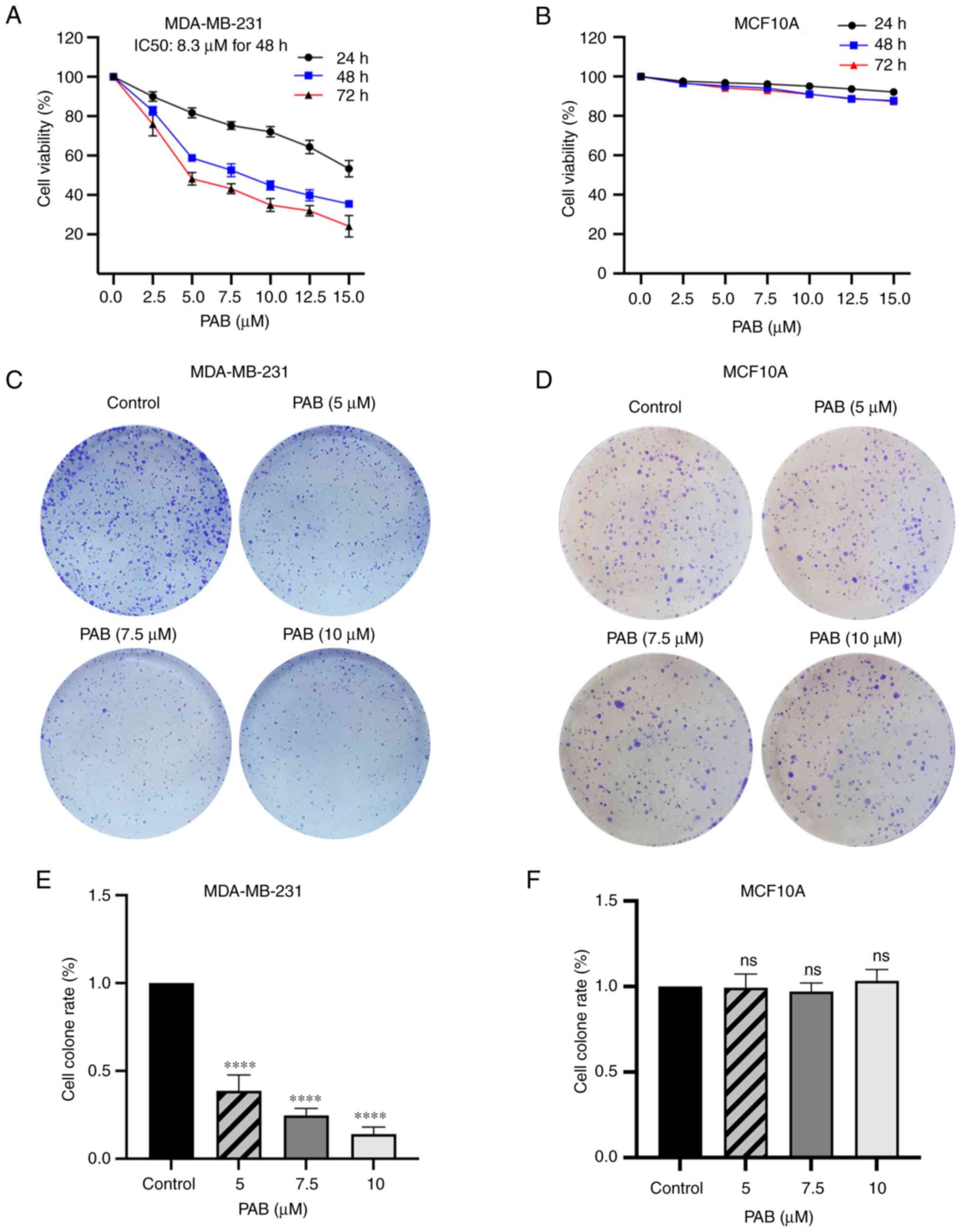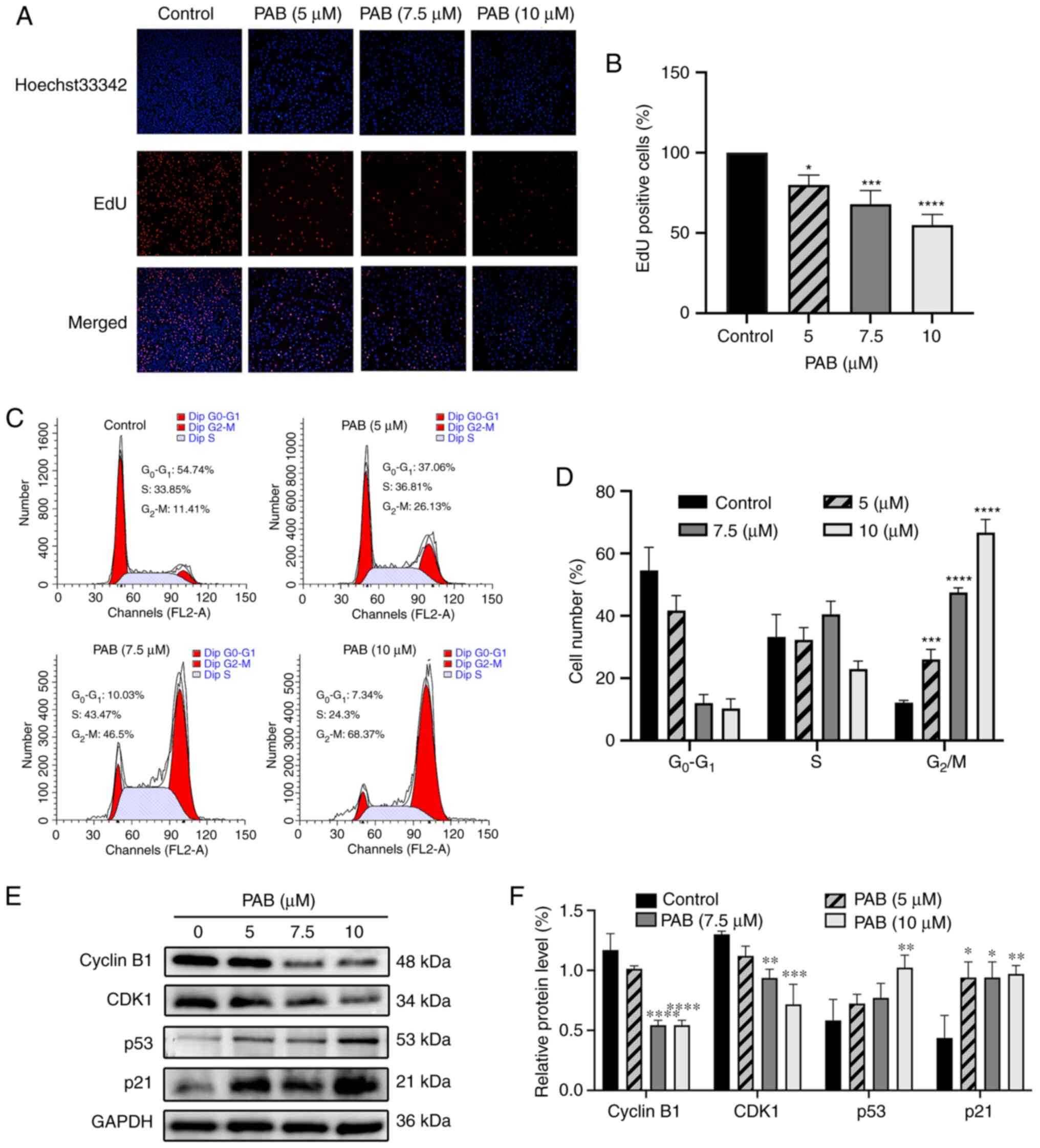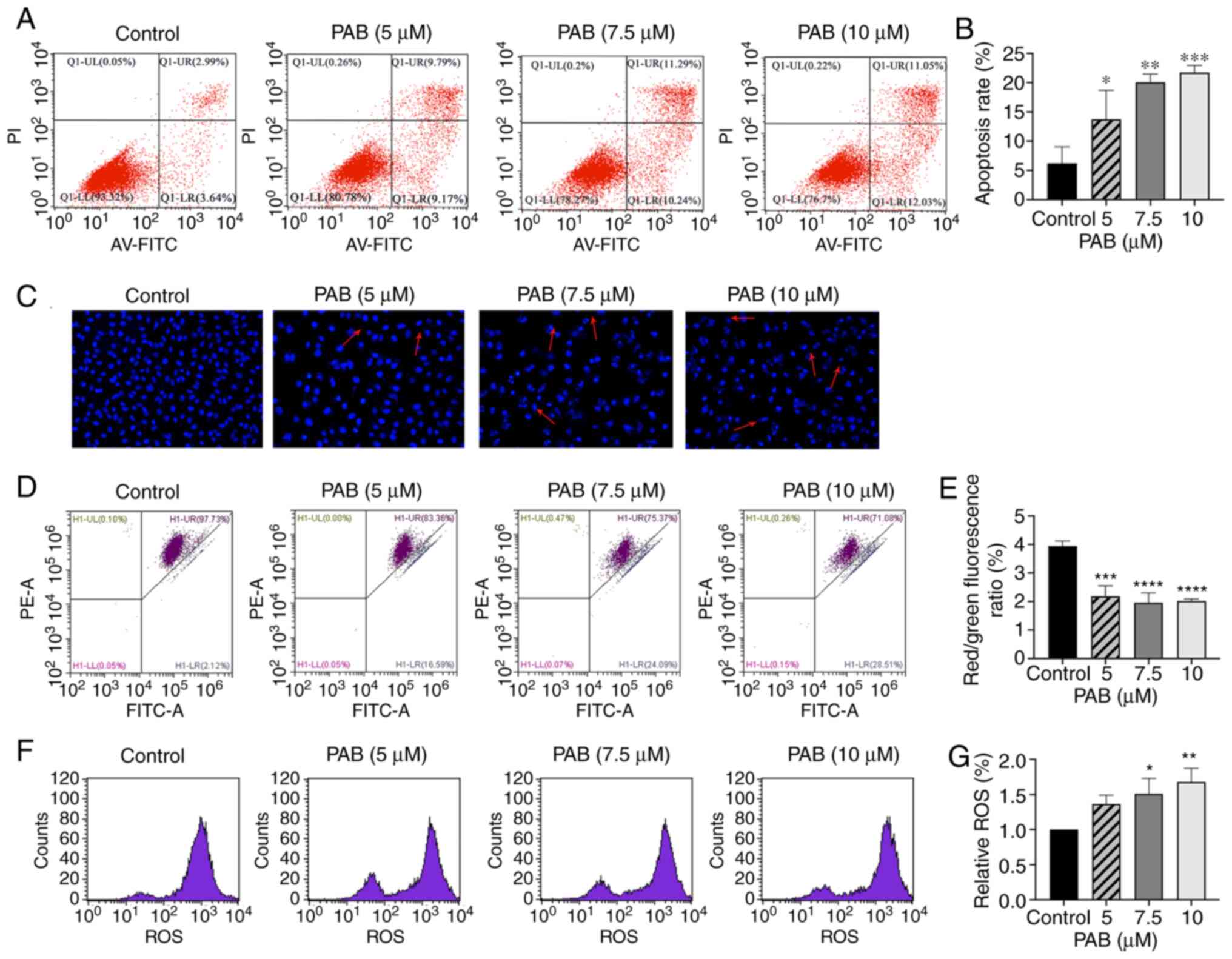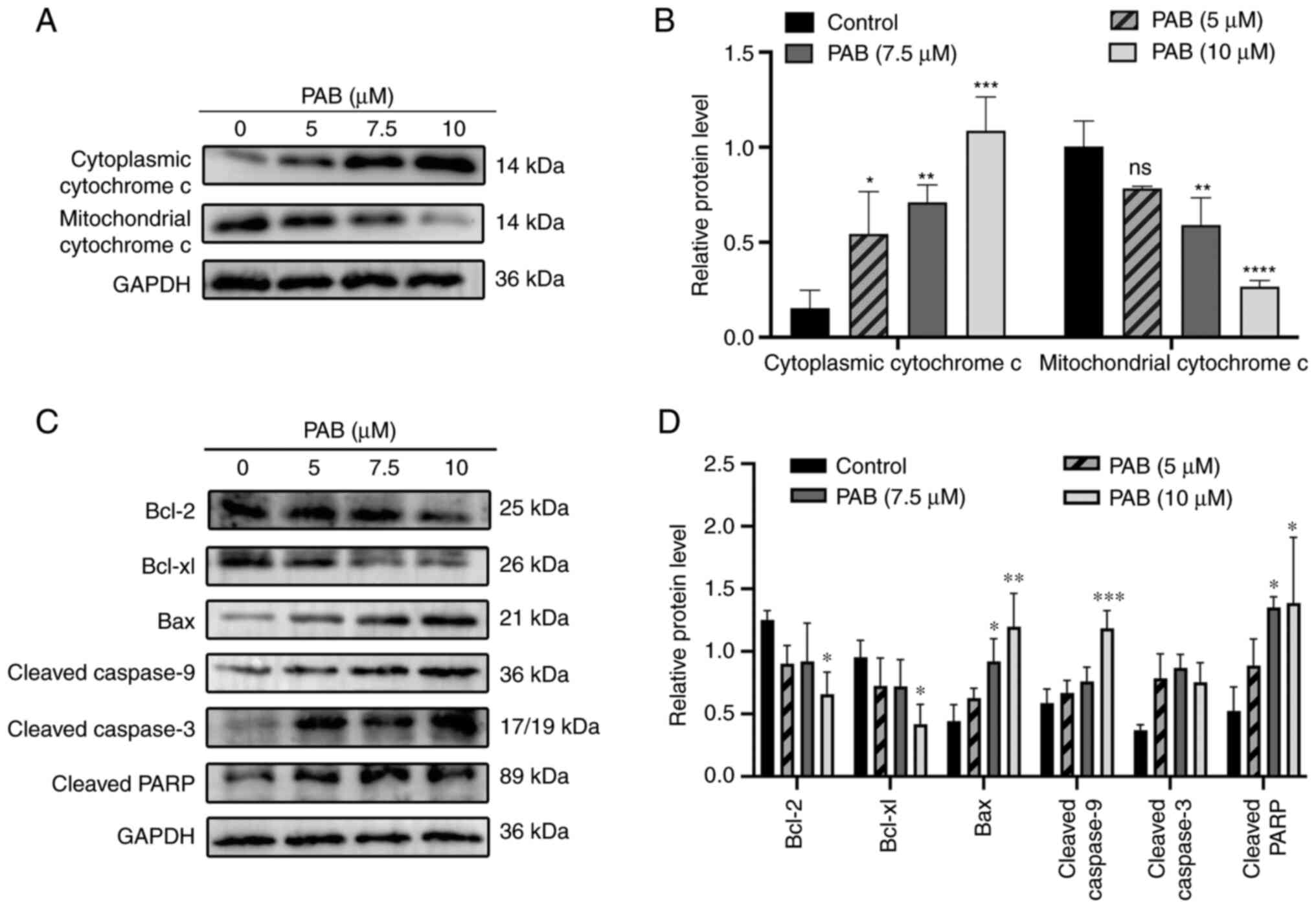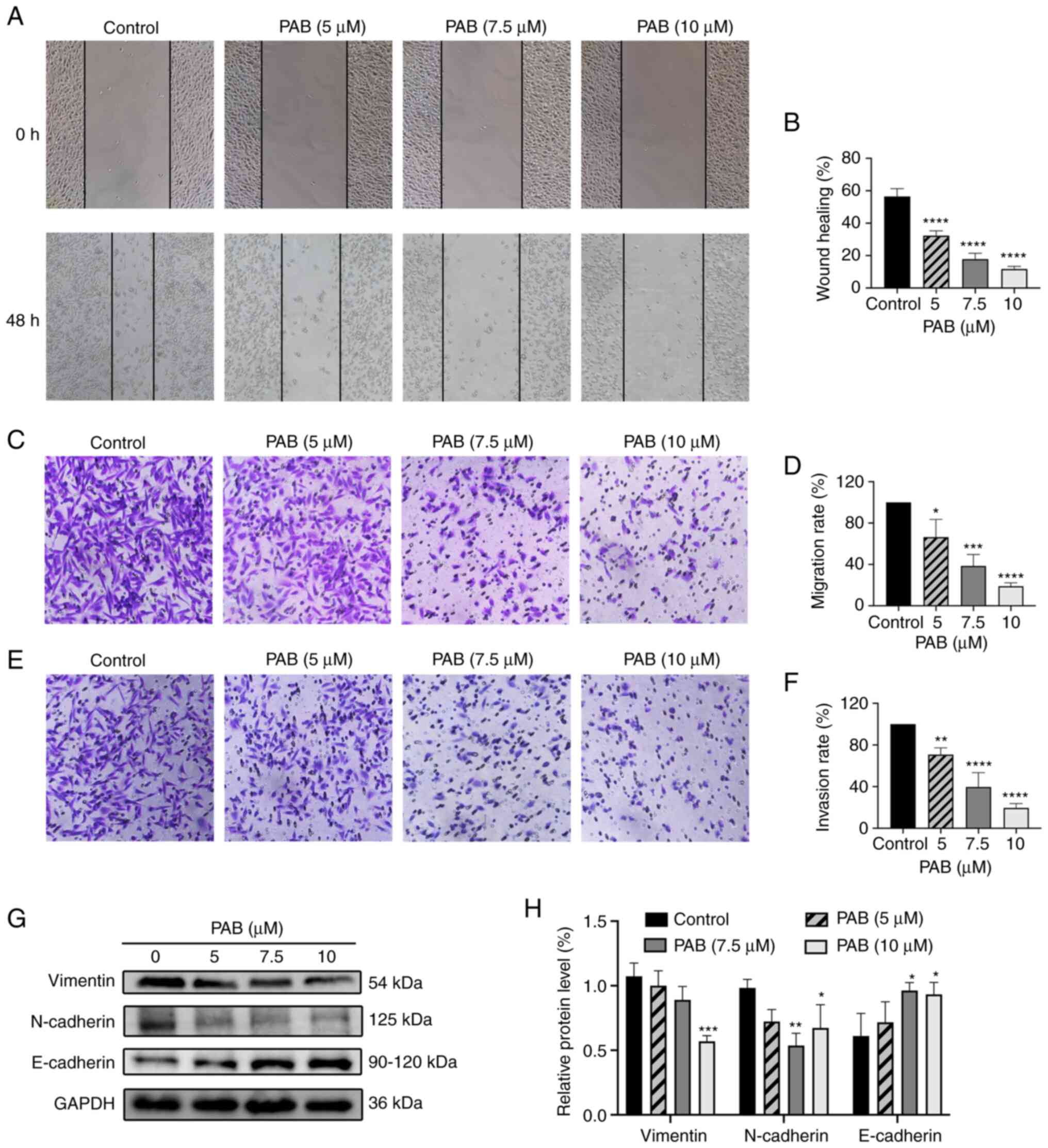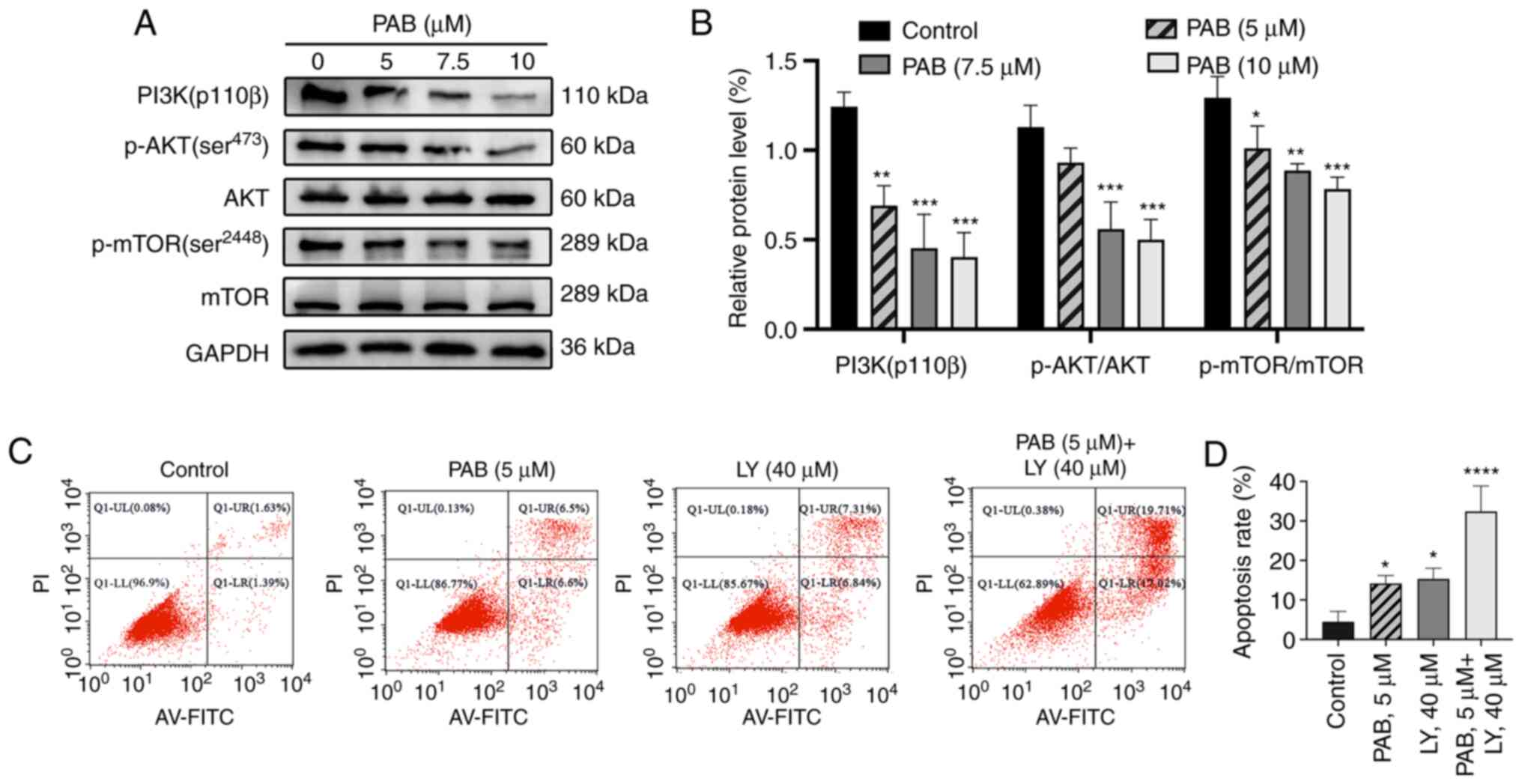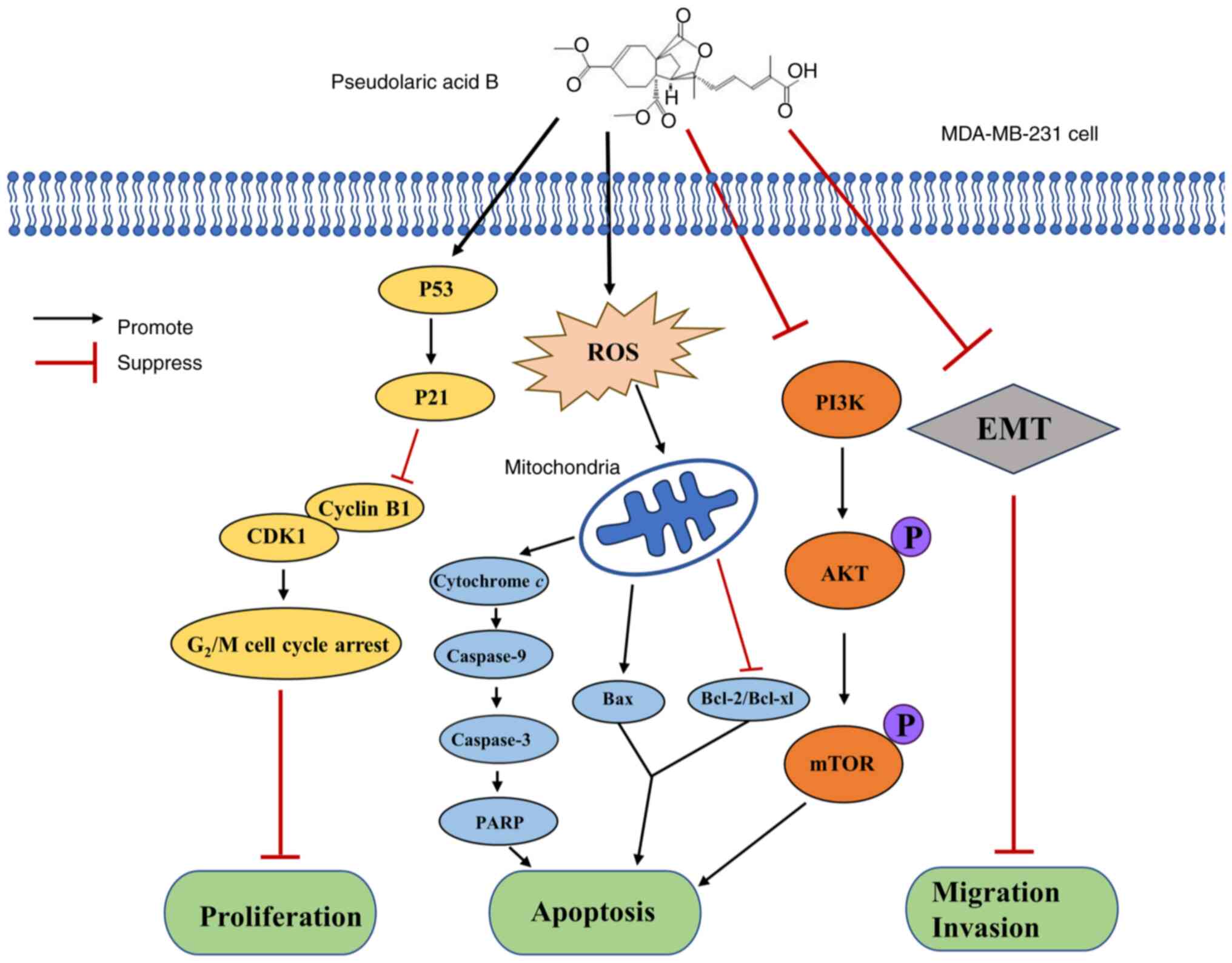|
1
|
Sung H, Ferlay J, Siegel RL, Laversanne M,
Soerjomataram I, Jemal A and Bray F: Global cancer statistics 2020:
GLOBOCAN estimates of incidence and mortality worldwide for 36
cancers in 185 countries. CA Cancer J Clin. 71:209–249. 2021.
View Article : Google Scholar : PubMed/NCBI
|
|
2
|
Yin L, Duan JJ, Bian XW and Yu SC:
Triple-negative breast cancer molecular subtyping and treatment
progress. Breast Cancer Res. 22:612020. View Article : Google Scholar : PubMed/NCBI
|
|
3
|
Garrido-Castro AC, Lin NU and Polyak K:
Insights into molecular classifications of triple-negative breast
cancer: Improving patient selection for treatment. Cancer Discov.
9:176–198. 2019. View Article : Google Scholar : PubMed/NCBI
|
|
4
|
Lu J, Guan H, Wu D, Hu Z, Zhang H, Jiang
H, Yu J, Zeng K, Li H, Zhang H, et al: Pseudolaric acid B
ameliorates synovial inflammation and vessel formation by
stabilizing PPARγ to inhibit NF-κB signalling pathway. J Cell Mol
Med. 25:6664–6678. 2021. View Article : Google Scholar : PubMed/NCBI
|
|
5
|
Li Z, Yin H, Chen W, Jiang C, Hu J, Xue Y,
Yao D, Peng Y and Hu X: Synergistic effect of pseudolaric Acid B
with fluconazole against resistant isolates and biofilm of candida
tropicalis. Infect Drug Resist. 13:2733–2743. 2020. View Article : Google Scholar : PubMed/NCBI
|
|
6
|
Miao ZH, Feng JM and Ding J: Newly
discovered angiogenesis inhibitors and their mechanisms of action.
Acta Pharmacol Sin. 33:1103–11. 2012. View Article : Google Scholar : PubMed/NCBI
|
|
7
|
Wei SF, He DH, Zhang SB, Lu Y, Ye X, Fan
XZ, Wang H, Wang Q and Liu YQ: Identification of pseudolaric acid B
as a novel Hedgehog pathway inhibitor in medulloblastoma. Biochem
Pharmacol. 190:1145932021. View Article : Google Scholar : PubMed/NCBI
|
|
8
|
Mafu S, Karunanithi PS, Palazzo TA, Harrod
BL, Rodriguez SM, Mollhoff IN, O'Brien TE, Tong S, Fiehn O,
Tantillo DJ, et al: Biosynthesis of the microtubule-destabilizing
diterpene pseudolaric acid B from golden larch involves an unusual
diterpene synthase. Proc Natl Acad Sci USA. 114:974–979. 2017.
View Article : Google Scholar : PubMed/NCBI
|
|
9
|
Zhang H, Li JC, Luo H, Zhao L, Zhang ZD
and Shen XF: Pseudolaric acid B exhibits anti-cancer activity on
human hepatocellular carcinoma through inhibition of multiple
carcinogenic signaling pathways. Phytomedicine. 59:1527592019.
View Article : Google Scholar : PubMed/NCBI
|
|
10
|
Wang D, Xin Y, Tian Y, Li W, Sun D and
Yang Y: Pseudolaric acid B inhibits gastric cancer cell metastasis
in vitro and in haematogenous dissemination model through PI3K/AKT,
ERK1/2 and mitochondria-mediated apoptosis pathways. Exp Cell Res.
352:34–44. 2017. View Article : Google Scholar : PubMed/NCBI
|
|
11
|
Yao GD, Yang J, Li XX, Song XY, Hayashi T,
Tashiro SI, Onodera S, Song SJ and Ikejima T: Blocking the
utilization of glucose induces the switch from senescence to
apoptosis in pseudolaric acid B-treated human lung cancer cells in
vitro. Acta Pharmacol Sin. 38:1401–1411. 2017. View Article : Google Scholar : PubMed/NCBI
|
|
12
|
Jiang L, Wen C, He Q, Sun Y, Wang J, Lan
X, Rohondia S, Dou QP, Shi X and Liu J: Pseudolaric acid B induces
mitotic arrest and apoptosis in both imatinib-sensitive and
-resistant chronic myeloid leukaemia cells. Eur J Pharmacol.
876:1730642020. View Article : Google Scholar : PubMed/NCBI
|
|
13
|
Hanahan D: Hallmarks of cancer: New
dimensions. Cancer Discov. 12:31–46. 2022. View Article : Google Scholar : PubMed/NCBI
|
|
14
|
Jeong SY and Seol DW: The role of
mitochondria in apoptosis. BMB Rep. 41:11–22. 2008. View Article : Google Scholar : PubMed/NCBI
|
|
15
|
Carneiro BA and El-Deiry WS: Targeting
apoptosis in cancer therapy. Nat Rev Clin Oncol. 17:395–417. 2020.
View Article : Google Scholar : PubMed/NCBI
|
|
16
|
Guan D, Li C, Lv X and Yang Y: Pseudolaric
acid B inhibits PAX2 expression through Wnt signaling and induces
BAX expression, therefore promoting apoptosis in HeLa cervical
cancer cells. J Gynecol Oncol. 30:e772019. View Article : Google Scholar : PubMed/NCBI
|
|
17
|
Choi SJ, Ahn CH, Yang IH, Jin B, Lee WW,
Kim JH, Ahn MH, Swarup N, Hong KO, Shin JA, et al: Pseudolaric Acid
B induces growth inhibition and caspase-dependent apoptosis on head
and neck cancer cell lines through death receptor 5. Molecules.
24:37152019. View Article : Google Scholar : PubMed/NCBI
|
|
18
|
Wen C, Chen J, Zhang D, Wang H, Che J, Qin
Q, He L, Cai Z, Lin M, Lou Q, et al: Pseudolaric acid B induces
mitotic arrest and apoptosis in both 5-fluorouracil-sensitive and
-resistant colorectal cancer cells. Cancer Lett. 383:295–308. 2016.
View Article : Google Scholar : PubMed/NCBI
|
|
19
|
Polivka J Jr and Janku F: Molecular
targets for cancer therapy in the PI3K/AKT/mTOR pathway. Pharmacol
Ther. 142:164–175. 2014. View Article : Google Scholar : PubMed/NCBI
|
|
20
|
Bartholomeusz C and Gonzalez-Angulo AM:
Targeting the PI3K signaling pathway in cancer therapy. Expert Opin
Ther Targets. 16:121–130. 2012. View Article : Google Scholar : PubMed/NCBI
|
|
21
|
Claerhout S, Decraene D, Van Laethem A,
Van Kelst S, Agostinis P and Garmyn M: AKT delays the
early-activated apoptotic pathway in UVB-irradiated keratinocytes
via BAD translocation. J Invest Dermatol. 127:429–438. 2007.
View Article : Google Scholar : PubMed/NCBI
|
|
22
|
Quan JH, Cha GH, Zhou W, Chu JQ, Nishikawa
Y and Lee YH: Involvement of PI 3 kinase/Akt-dependent Bad
phosphorylation in Toxoplasma gondii-mediated inhibition of host
cell apoptosis. Exp Parasitol. 133:462–471. 2013. View Article : Google Scholar : PubMed/NCBI
|
|
23
|
Fulda S: Synthetic lethality by
co-targeting mitochondrial apoptosis and PI3K/Akt/mTOR signaling.
Mitochondrion. 19:85–87. 2014. View Article : Google Scholar : PubMed/NCBI
|
|
24
|
Zuo A, Zhao P, Zheng Y, Hua H and Wang X:
Tripterine inhibits proliferation, migration and invasion of breast
cancer MDA-MB-231 cells by up-regulating microRNA-15a. Biol Chem.
400:1069–1078. 2019. View Article : Google Scholar : PubMed/NCBI
|
|
25
|
Yang W, Feng B, Meng Y, Wang J, Geng B,
Cui Q, Zhang H, Yang Y and Yang J: FAM3C-YY1 axis is essential for
TGFβ-promoted proliferation and migration of human breast cancer
MDA-MB-231 cells via the activation of HSF1. J Cell Mol Med.
23:3464–3475. 2019. View Article : Google Scholar : PubMed/NCBI
|
|
26
|
Lou C, Xu X, Chen Y and Zhao H: Alisol A
suppresses proliferation, migration, and invasion in human breast
cancer MDA-MB-231 cells. Molecules. 24:36512019. View Article : Google Scholar : PubMed/NCBI
|
|
27
|
Kheirandish-Rostami M, Roudkenar MH,
Jahanian-Najafabadi A, Tomita K, Kuwahara Y, Sato T and Roushandeh
AM: Mitochondrial characteristics contribute to proliferation and
migration potency of MDA-MB-231 cancer cells and their response to
cisplatin treatment. Life Sci. 244:1173392020. View Article : Google Scholar : PubMed/NCBI
|
|
28
|
Tohkayomatee R, Reabroi S, Tungmunnithum
D, Parichatikanond W and Pinthong D: Andrographolide exhibits
anticancer activity against breast cancer cells (MCF-7 and
MDA-MB-231 cells) through suppressing cell proliferation and
inducing cell apoptosis via inactivation of ER-α receptor and
PI3K/AKT/mTOR signaling. Molecules. 27:35442022. View Article : Google Scholar : PubMed/NCBI
|
|
29
|
Yu B, Yue DM, Shu LH, Li NJ and Wang JH:
Pseudolaric acid B induces caspase-dependent cell death in human
ovarian cancer cells. Oncol Rep. 31:849–857. 2014. View Article : Google Scholar : PubMed/NCBI
|
|
30
|
Wang D, Tian Y, Feng W, Zhao L, Zhao M,
Liu J and Wang Q: Pseudolaric acid B induces endometrial cancer
Ishikawa cell apoptosis and inhibits metastasis through AKT-GSK-3β
and ERK1/2 signaling pathways. Anticancer Drugs. 28:603–612. 2017.
View Article : Google Scholar : PubMed/NCBI
|
|
31
|
Li X, Zhao X, Song W, Tian Z, Yang L, Niu
Q, Zhang Q, Xie M, Zhou B, Xu Y, et al: Pseudolaric Acid B inhibits
proliferation, invasion and Epithelial-to-mesenchymal transition in
human pancreatic cancer cell. Yonsei Med J. 59:20–27. 2018.
View Article : Google Scholar : PubMed/NCBI
|
|
32
|
Matthews HK, Bertoli C and de Bruin RAM:
Cell cycle control in cancer. Nat Rev Mol Cell Biol. 23:74–88.
2022. View Article : Google Scholar : PubMed/NCBI
|
|
33
|
Dong C, Wen S, Zhao S, Sun S, Zhao S, Dong
W, Han P, Chen Q, Gong T, Chen W, et al: Salidroside inhibits
reactive astrogliosis and glial scar formation in late cerebral
ischemia via the Akt/GSK-3β pathway. Neurochem Res. 46:755–769.
2021. View Article : Google Scholar : PubMed/NCBI
|
|
34
|
Bao Y, Wu X, Jin X, Kanematsu A, Nojima M,
Kakehi Y and Yamamoto S: Apigenin inhibits renal cell carcinoma
cell proliferation through G2/M phase cell cycle arrest. Oncol Rep.
47:602022. View Article : Google Scholar : PubMed/NCBI
|
|
35
|
He YC, He L, Khoshaba R, Lu FG, Cai C,
Zhou FL, Liao DF and Cao D: Curcumin nicotinate selectively induces
cancer cell apoptosis and cycle arrest through a P53-mediated
mechanism. Molecules. 24:41792019. View Article : Google Scholar : PubMed/NCBI
|
|
36
|
Ma K, Wang K, Zhou Y, Liu N, Guo W, Qi J,
Hu Z, Su S, Tang P and Zhou X: Purified vitexin compound 1 serves
as a promising antineoplastic agent in ovarian cancer. Front Oncol.
11:7347082021. View Article : Google Scholar : PubMed/NCBI
|
|
37
|
Xie B, Wang S, Jiang N and Li JJ: Cyclin
B1/CDK1-regulated mitochondrial bioenergetics in cell cycle
progression and tumor resistance. Cancer Lett. 443:56–66. 2019.
View Article : Google Scholar : PubMed/NCBI
|
|
38
|
Fischer M, Quaas M, Steiner L and Engeland
K: The p53-p21-DREAM-CDE/CHR pathway regulates G2/M cell cycle
genes. Nucleic Acids Res. 44:164–174. 2016. View Article : Google Scholar : PubMed/NCBI
|
|
39
|
Engeland K: Cell cycle arrest through
indirect transcriptional repression by p53: I have a DREAM. Cell
Death Differ. 25:114–132. 2018. View Article : Google Scholar : PubMed/NCBI
|
|
40
|
Abate M, Festa A, Falco M, Lombardi A,
Luce A, Grimaldi A, Zappavigna S, Sperlongano P, Irace C, Caraglia
M and Misso G: Mitochondria as playmakers of apoptosis, autophagy
and senescence. Semin Cell Dev Biol. 98:139–153. 2020. View Article : Google Scholar : PubMed/NCBI
|
|
41
|
Yang Y, Karakhanova S, Hartwig W, D'Haese
JG, Philippov PP, Werner J and Bazhin AV: Mitochondria and
mitochondrial ROS in cancer: Novel targets for anticancer therapy.
J Cell Physiol. 231:2570–2581. 2016. View Article : Google Scholar : PubMed/NCBI
|
|
42
|
Cao K and Tait SWG: Apoptosis and cancer:
Force awakens, phantom menace, or both? Int Rev Cell Mol Biol.
337:135–152. 2018. View Article : Google Scholar : PubMed/NCBI
|
|
43
|
Deepak KGK, Vempati R, Nagaraju GP, Dasari
VR, S N, Rao DN and Malla RR: Tumor microenvironment: Challenges
and opportunities in targeting metastasis of triple negative breast
cancer. Pharmacol Res. 153:1046832020. View Article : Google Scholar : PubMed/NCBI
|
|
44
|
Hosonaga M, Saya H and Arima Y: Molecular
and cellular mechanisms underlying brain metastasis of breast
cancer. Cancer Metastasis Rev. 39:711–720. 2020. View Article : Google Scholar : PubMed/NCBI
|
|
45
|
Rakha EA and Chan S: Metastatic
triple-negative breast cancer. Clin Oncol (R Coll Radiol).
23:587–600. 2011. View Article : Google Scholar : PubMed/NCBI
|
|
46
|
Pastushenko I and Blanpain C: EMT
transition states during tumor progression and metastasis. Trends
Cell Biol. 29:212–226. 2019. View Article : Google Scholar : PubMed/NCBI
|
|
47
|
Zhang Y and Weinberg RA:
Epithelial-to-mesenchymal transition in cancer: Complexity and
opportunities. Front Med. 12:361–373. 2018. View Article : Google Scholar : PubMed/NCBI
|
|
48
|
Aiello NM and Kang Y: Context-dependent
EMT programs in cancer metastasis. J Exp Med. 216:1016–1026. 2019.
View Article : Google Scholar : PubMed/NCBI
|
|
49
|
Yu J, Chen C, Xu T, Yan M, Xue B, Wang Y,
Liu C, Zhong T, Wang Z, Meng X, et al: Pseudolaric acid B activates
autophagy in MCF-7 human breast cancer cells to prevent cell death.
Oncol Lett. 11:1731–1737. 2016. View Article : Google Scholar : PubMed/NCBI
|















